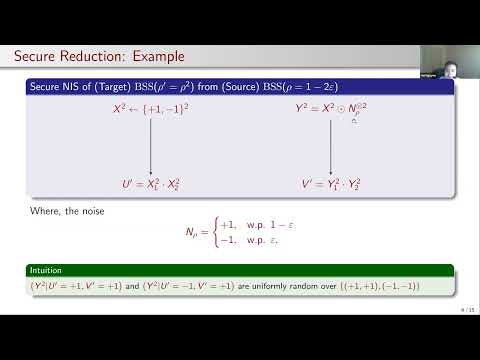CryptoDB
Secure Non-interactive Simulation: Feasibility and Rate
| Authors: |
|
|---|---|
| Download: | |
| Presentation: | Slides |
| Conference: | EUROCRYPT 2022 |
| Abstract: | A natural solution to increase the efficiency of secure computation will be to non-interactively and securely transform diverse inexpensive-to-generate correlated randomness, like, joint samples from noise sources, into correlations useful for secure computation protocols. Motivated by this general application for secure computation, our work introduces the notion of {\em secure non-interactive simulation} (\snis). Parties receive samples of correlated randomness, and they, without any interaction, securely convert them into samples from another correlated randomness. Our work presents a simulation-based security definition for \snis and initiates the study of the feasibility and efficiency of \snis. We also study \snis among fundamental correlated randomnesses like random samples from the binary symmetric and binary erasure channels, represented by \BSC and \BEC, respectively. We show the impossibility of interconversion between \BSC and \BEC samples. Next, we prove that a \snis of a $\BEC(\eps')$ sample (a \BEC with noise characteristic $\eps'$) from $\BEC(\eps)$ is feasible if and only if $(1-\eps') = (1-\eps)^k$, for some $k\in\NN$. In this context, we prove that all \snis constructions must be linear. Furthermore, if $(1-\eps') = (1-\eps)^k$, then the rate of simulating multiple independent $\BEC(\eps')$ samples is at most $1/k$, which is also achievable using (block) linear constructions. Finally, we show that a \snis of a $\BSC(\eps')$ sample from $\BSC(\eps)$ samples is feasible if and only if $(1-2\eps')=(1-2\eps)^k$, for some $k\in\NN$. Interestingly, there are linear as well as non-linear \snis constructions. When $(1-2\eps')=(1-2\eps)^k$, we prove that the rate of a {\em perfectly secure} \snis is at most $1/k$, which is achievable using linear and non-linear constructions. Our technical approach algebraizes the definition of \snis and proceeds via Fourier analysis. Our work develops general analysis methodologies for Boolean functions, explicitly incorporating cryptographic security constraints. Our work also proves strong forms of {\em statistical-to-perfect security} transformations: one can error-correct a statistically secure \snis to make it perfectly secure. We show a connection of our research with {\em homogeneous Boolean functions} and {\em distance-invariant codes}, which may be of independent interest. |
Video from EUROCRYPT 2022
BibTeX
@inproceedings{eurocrypt-2022-31923,
title={Secure Non-interactive Simulation: Feasibility and Rate},
publisher={Springer-Verlag},
author={Hamidreza Amini Khorasgani and Hemanta K. Maji and Hai H. Nguyen},
year=2022
}

